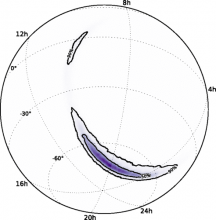
Abstract
On September 14, 2015, the Laser Interferometer Gravitational-Wave Observatory (LIGO) detected a gravitational-wave transient (GW150914); we characterize the properties of the source and its parameters. The data around the time of the event were analyzed coherently across the LIGO network using a suite of accurate waveform models that describe gravitational waves from a compact binary system in general relativity. GW150914 was produced by a nearly equal mass binary black hole of masses 36+5−4M⊙ and 29+4−4M⊙; for each parameter we report the median value and the range of the 90% credible interval. The dimensionless spin magnitude of the more massive black hole is bound to be <0.7 (at 90% probability). The luminosity distance to the source is 410+160−180 Mpc, corresponding to a redshift 0.09+0.03−0.04 assuming standard cosmology. The source location is constrained to an annulus section of 610 deg2, primarily in the southern hemisphere. The binary merges into a black hole of mass 62+4−4M⊙ and spin 0.67+0.05−0.07. This black hole is significantly more massive than any other inferred from electromagnetic observations in the stellar-mass regime.